Greater than 17 minutes, my friend!
Content Marketing for Translators A complete guide to content marketing: from keyword research to lead capture
Content marketing for translators is an instrument for inbound marketing by which you strategically create and distribute content in order to attract, qualify and convert leads.
It’s a lot more involved than just writing blog posts. Before you start content marketing, you’ll need to know your business goals and strategy and buyer persona better than you know your childhood hometown.
Content marketing may not be for everyone.
But it’s the main and cheapest way people can rank on Google and establish themselves as authorities in their niche. So today I’m writing a guide about content marketing for translators.
This post is for:
- Freelance translators who want to use content marketing to promote their own business.
- Translators who want to diversify and:
- Translate for content marketing purposes or
- Become content marketers.
Whatever you are, you will have a deeper understanding of content marketing after reading this.
Ready to start? Download my free content editorial calendar template!
Index:
- What is inbound marketing?
- What is content marketing?
- Creating your buyer persona
- Buyer’s Journey
- Creating a content marketing plan
- Search Engine Optimization (SEO)
- Lead generation
- Promotion
What is inbound marketing?
Inbound marketing, as you may guess from the name, is the opposite of outbound marketing. Outbound marketing is when you reach out to prospects.
Outbound marketing is when you’re the one initiating the conversation with your leads. It’s radio ads, paid advertising, prospecting and calling potential leads.
I do not think that inbound is a replacement for outbound. Especially if you’re starting out as a freelance translator, you should be doing client outreach as this will be your initial best bet at landing clients. Inbound takes time to build.
Inbound marketing is a process whereby you bring the clients to you (different from word-of-mouth marketing). It is a long-term business strategy, not a short-term marketing solution.
Inbound marketing uses content marketing to draw leads to your website and turn them into customers.
What is content marketing?
The purpose of content marketing is to:
- Attract visitors to your website
- Qualify them as leads
- Get them onto your radar and database (email list, most of the time)
- Delight customers
- Establish brand as authority in niche
- Create a community
It’s where you create different kinds of content in a strategic way to start getting leads down your pipeline. The kinds of content you can create in content marketing is:
- Blog articles
- Emails
- Checklists
- Infographics
- Podcasts
- Videos
- Templates
- Ebooks
But there’s a certain order to do things in. It’s not about just creating all this stuff, throwing it out into the world, and hoping something happens. Before you start creating the content, you have to do some background work.
The first step is understanding your customer.
Creating your Buyer Persona
Before you can create any content, you need to create your buyer persona, also known as a customer avatar. A lot of people will tell you that this is about their demographics, geographic location, age-range and how many children they have.
Okay, maybe those things come into play. But I wonder how many of you have created a buyer persona based on those things and have ever looked back on these documents (assuming you’ve documented it) and actually used any of that information. Has that ever given you tangible results?
My bets are on no. Yes, to a degree, those things are important, but what’s most important to me (and what should be to you) are what their challenges are and how you are solving them.
So instead of speculating about how old your client’s children are, how about you start digging and figure out what position they have in the company, what their boss’s expectations are of them, and how translation makes a difference in their work.
Do me and yourself a favor: don’t guess this information. If you already have clients, call them up, talk to them, and create a voice of customer document where you log the kind of language they use and questions they’re asking.
Then you’re going to use that very language in your copy and your keyword research.
But that’s for another blog post. But before you can start, you need to understand your customer deeply and know what they need from translation for their jobs to succeed.
Buyer’s Journey
Next step before you can create your plan is to understand the buyer’s journey and what the sales funnel of your profession or industry looks like.
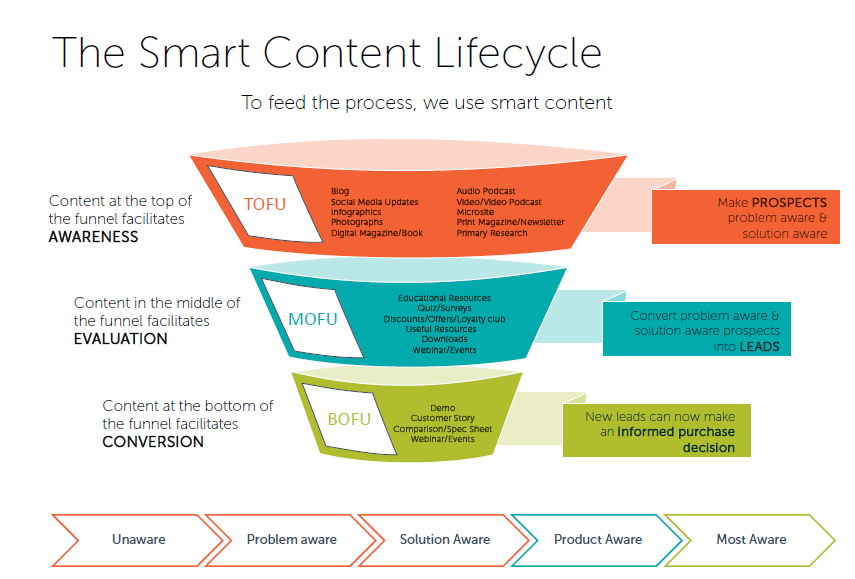
A sales funnel illustrates the theoretical journey a customer takes from visiting your website until sending you a wire transfer. The top of the funnel (ToFu) is where you attract them to your freelance translator website.
You can and should create blog posts and use SEO at all levels of the funnel, despite many infographics and online posts telling you that blog posts only belong in awareness. I repeat: use blog posts at ALL levels of the marketing/sales funnel.
Normally you have the most amount of content at the top, raising brand awareness and teaching people about the broader aspects of your industry (only in a way that is useful or entertaining to them, of course).
As you move down the funnel, you start to get longer and more specific, and really start teaching people how to solve a problem you helped them discover they have.
Not all industries will have the same content marketing approach.
Figure out where your clients are in the marketing funnel. For most industries, you will have the highest volume of content at the top of the funnel and the least amount at the bottom of the funnel.
But translation isn’t most industries, is it?
Here’s the nitty-gritty of our situation:
- You most likely don’t have a marketing team
- Your favorite thing to do is translate, not create content (not my case, but maybe yours!)
- You have limited time and budget
I personally love having a blog and creating content. I especially love it when clients have a big budget which allows me time and resources to create tons of content for all parts of the funnel. Sometimes we don’t have that luxury when we’re marketing for ourselves.
You may not have the capacity to create that much content. I suggest, while not ignoring the other parts of the funnel, to focus your efforts on BoFu (bottom of the funnel) content using high-intent keywords. This means using keywords for people who are looking to buy.
Not everyone will agree with me on this and, of course, everyone’s business is different.
But the reason I think that is that, if you’re going to spend the little time you have creating content, it might as well be for people who are ready to hire a premium translator instead of those who are wondering whether they want to reach the Spanish market.
That’s my recommendation if you can’t commit to much creation, but ultimately you know your audience better than I do.
If you think about it, our clients come to us already knowing they want a freelance translator. They are in the consideration/decision phase of the journey and just want to choose the right one.
Maybe I’m confusing you. Don’t get too attached to this point. Let’s move on.
I also don’t want to bore you with jargon.
I talk more about intent below.
Creating a content marketing plan
Now that you’ve studied (and talked to) your buyers and started (it’s never finished) your voice of customer document, you understand your customers’ needs at each stage of the buyer’s journey, it’s time to create a content marketing plan.
This will include choosing the topics to write about, researching keywords to write blog posts about, creating lead magnets based on those blog posts, and planning how you’re going to distribute content.
When you think about each piece blog post you’ll create, ask yourself:
- Will somebody want to link back to this post? (is there new information, lots of data, lots of images, or original quotes from well-connected people?). God knows the internet has enough generic “why professional translators are better than machine translation” posts
- Do I know anyone who would be interested in sharing this post with their peers or community?
- Can I link this to a relevant lead magnet or downloadable so that these people will join my mailing list?
Answering these questions as you plan your posts will help have a successful strategy.
Now let’s talk about research to perform in order to find the right keywords to use for your content.
Do your keyword research (instructions below) and come up with 12 week’s worth of blog posts, and related offers/ lead magnets that will go with your post. It’ll be easiest if the blog posts form a content cluster around a single topic.
Write out a list of topics and put them in your content calendar.
Want to use the same content editorial calendar I use for this blog? Get free access to it here!
Search Engine Optimization (SEO)

Learning about content marketing for translators should include a brief lesson on SEO. Optimizing your blog posts for search engines is the “free” way to get traffic. And if you’re just launching your website now and don’t plan to use paid advertising, it’s the only way to get any traffic.
SEO is important at every part of the buyer’s journey. But you can’t just guess what words people use to find freelance translators online. Use tools available to you to find these keywords on which you will base your blog articles.
Ubersuggest is a free one, and if you get more advanced or become a content marketer, then you can switch to paid tools like Ahrefs and SEMrush.
Find the keyword sweet spot of high search volume but lowest competition.
The purpose of using (well-researched) keywords in your blog posts is
- For people to find your posts as they search
- For Google to know that your website is relevant to what people are searching for.
You will use your primary keyword in your title, throughout your blog post and in your meta description.
The Google algorithm is smart and you can use different semantic variants of your keywords throughout your writing. But you need to be sure the variants you’re using are things people are actually searching for.
Ranking on Google
One of a content marketer’s main goals is to rank on the first page of Google. Preferably, in the top 5. But with 4 million new blog posts being published every day, how the F can you compete?
There are a few things that influence this:
- How many other posts you’re competing with for your keyword
- Websites linking to your blog post
- Keyword intent (more on this below)
- Your domain authority/power
- The quality and comprehensiveness of your content
- Freshness of the content
Some of these you can’t always control, like your domain authority or backlinks. What you can control is choosing the right keyword and the quality and comprehensiveness of your content.
If your piece is more comprehensive, engaging and data-backed than the top 5 pieces on the front page, you’re already on the right path forward.
Okay, *wipes brow*, now how do you find the right keywords to use?
Related Post: Create a Freelance Translator Website that Gets Clients Calling
Keyword research
Keyword research is complicated and often overwhelming. I’ll try to go over the basics.
Long-tail keywords are long and specific entries into the search engine. These will be questions like “how to do content marketing for freelance translators” or “SEO tips for freelance translators” instead of just “content marketing” or “SEO” (the latter which are impossible to rank for if you aren’t going to build links).
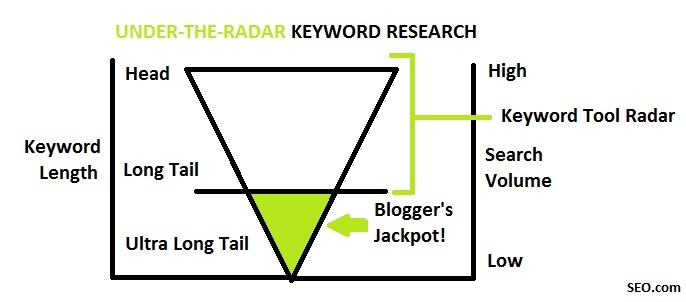
You can type in a question you think of and use Google’s suggestions to come up with more keywords. For example, if I type “content marketing for freelancer” in Google, I will look in three different areas. The search suggestion:
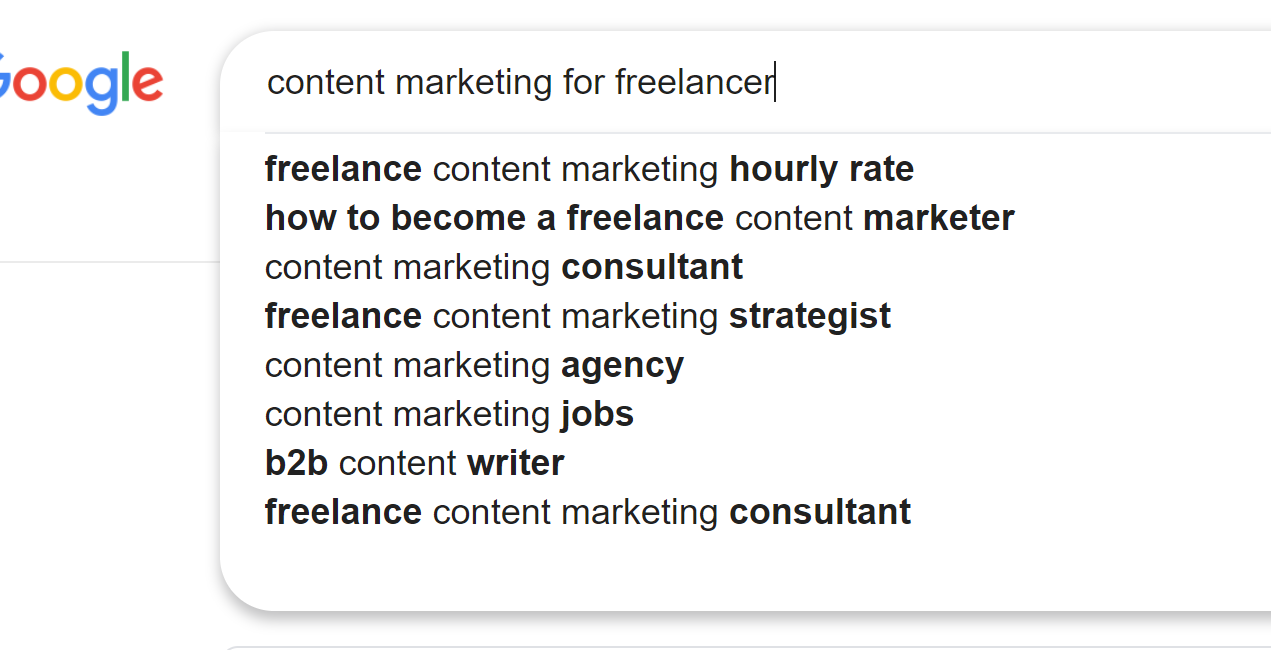
Sometimes you can see the “people also ask” section, which shows me the following:
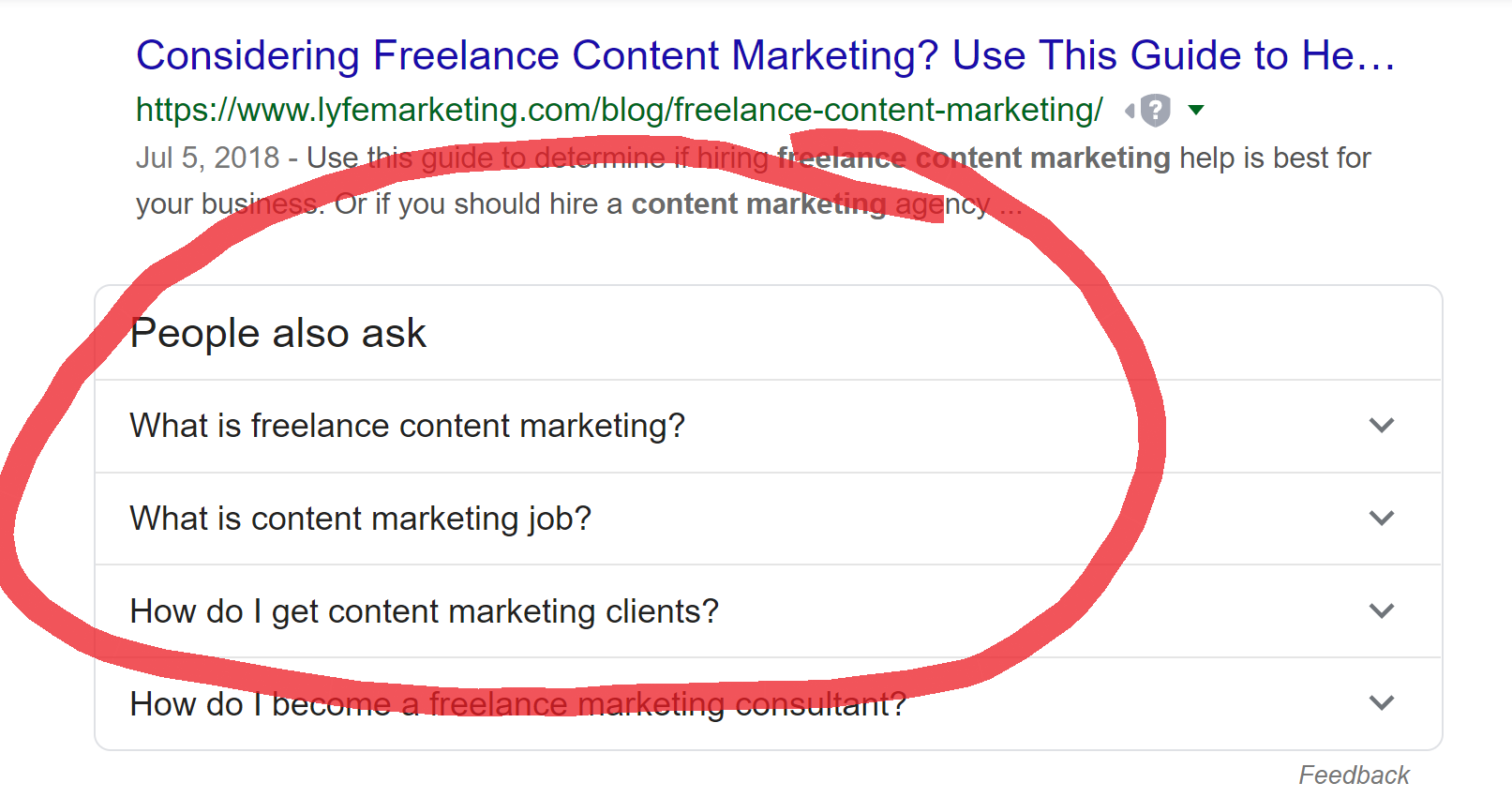
So now I’m starting to understand the intent of this keyword. People aren’t typing this to find out how to use content marketing for themselves, but rather how to start working as a content marketer. Last place I look is all the way at the bottom, “related searches”:
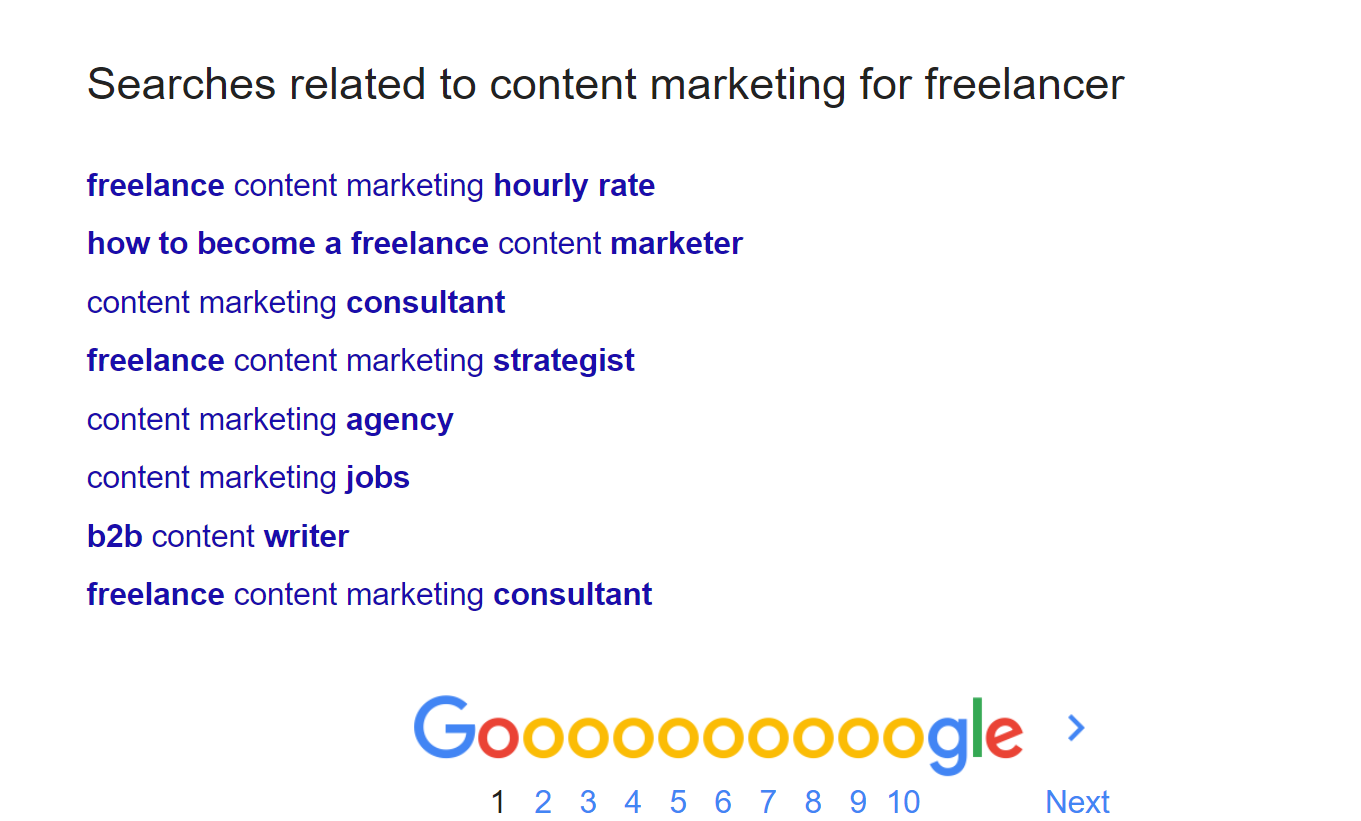
So now I’ve got a bunch of keywords that I can start working with and coming up with topics. But what’s up with the intent?
Buyer intent
One of the most important aspects for ranking on Google is making sure you understand the intentof the keyword. As a translator, this should be your forte, right?
Google’s algorithm is advanced enough to understand whether your blog posts meet the intent that the user was searching for. It bases this on a mix of looking at the other results in terms of category and format, as well as other factors like how many people click on your link or how much time people spend on your blog post.
For example, let’s say I am trying to promote my French to English translation services and I want to rank for the keyword French to English translation. The first thing I’ll do is type that into Google. What do I get?
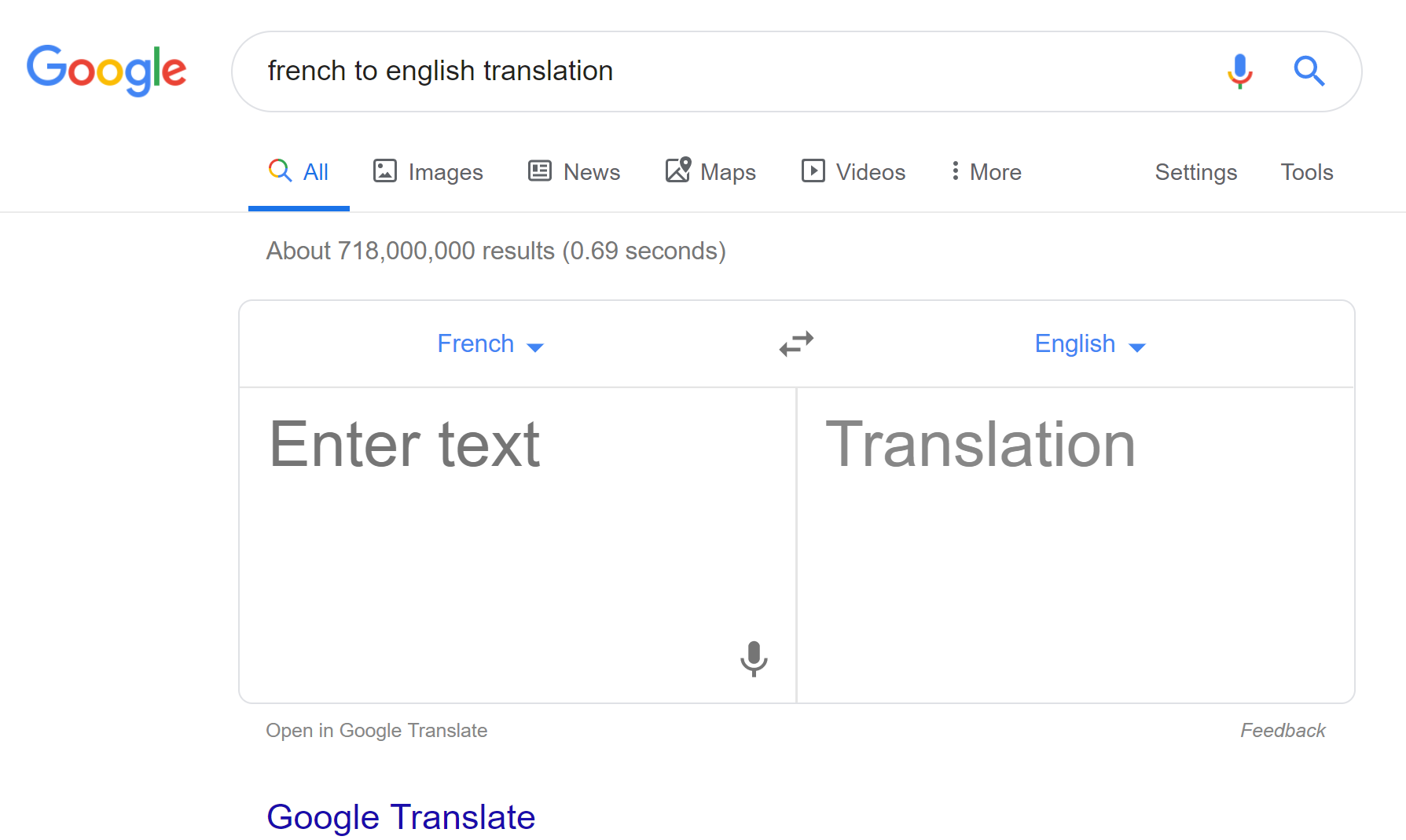
Aside from the nearly 1 billion other results to compete with, the first thing I get is our best friend Google Translate. What’s next?
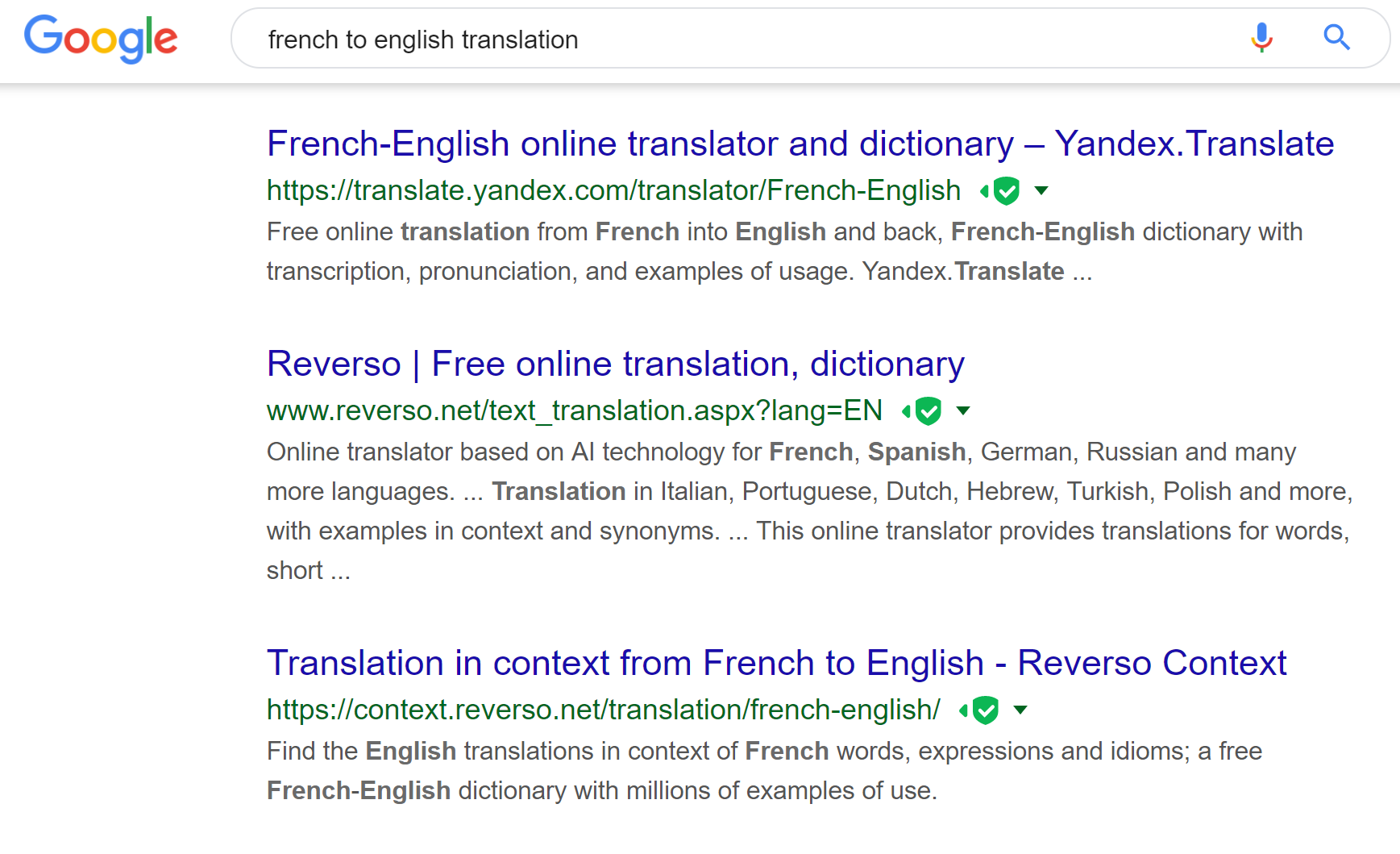
Just dictionaries.
Now, instead of telling you, let me ask you. Does the intent of this search, to you, seem like somebody is looking to pay lots of money for premium, professional translation?
Nope.
So there is no point in trying to rank for this keyword, besides the issue that the competition would make it impossible anyway.
You cannot change the user’s search intent. Do not try to trick them into opening your post if you’re going to give them something totally different. That will not help you. It doesn’t matter how convincing your article is!
I tried that with a post about Cheap Translation Services, which was a post in disguise actually mocking cheap translations. But I didn’t think about how I would only attract only people that were literally looking for cheap translation services.
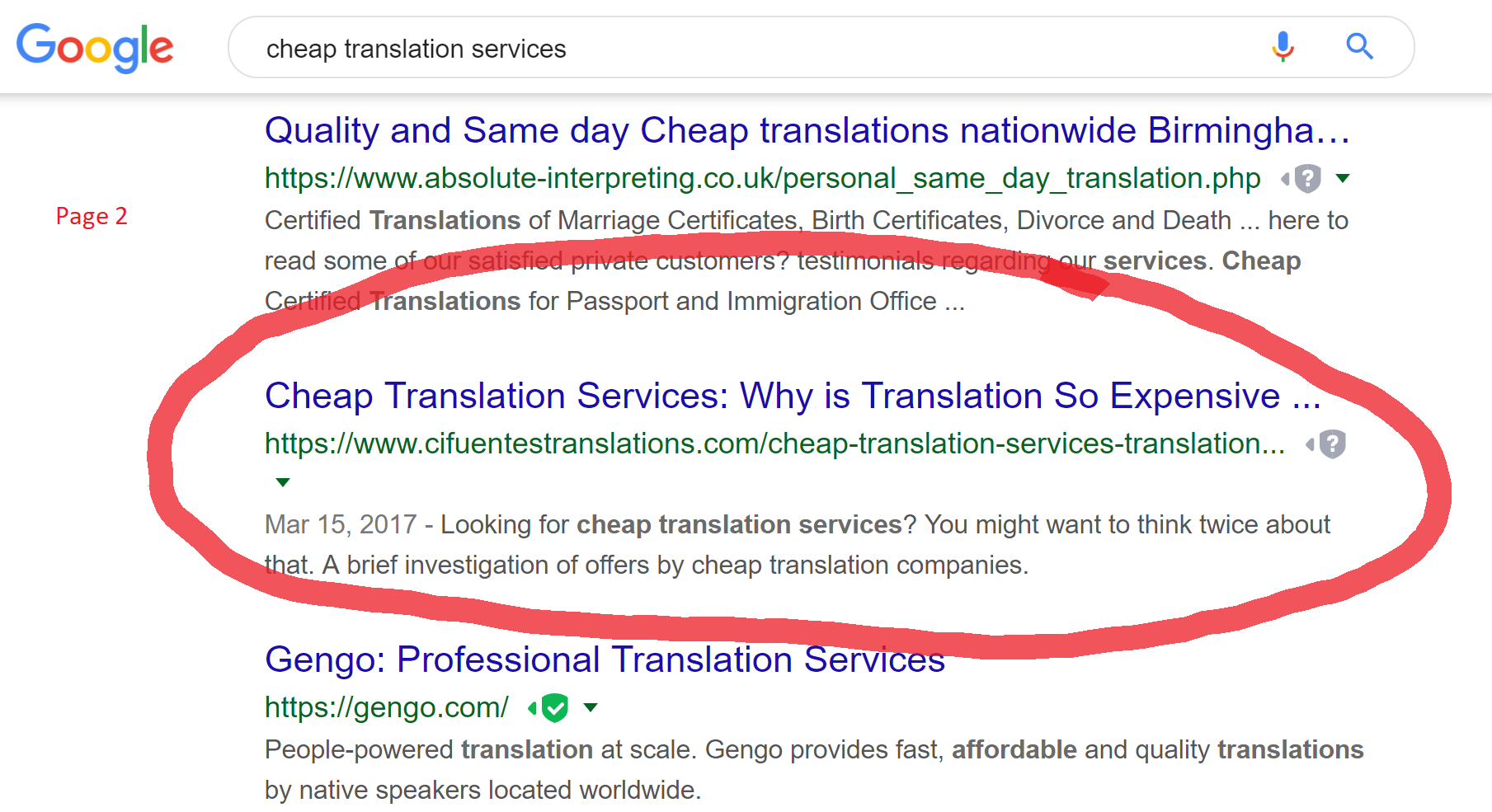
Why did I want to do that? I thought that it would help my page rank on Google. Well, it did, but only for cheap people. I had reached page one, and since people were disappointed to find out they wouldn’t find what they were looking for, I’ve been moved down to page 2 (still not too shabby).
Make sure you have the intent of your buyer right. They use Google to find the answers to their questions. You aren’t going to convince them of anything by tricking them into reading something else.
You will only move your page down the ranks.
Now, once you’ve got them on your page, it’s time to get them onto your mailing list (so they can KEEP coming back to your page). How can you do that?
Ready to start? Download my free content editorial calendar template!
Lead Generation

A lead is someone who has expressed interest in your product and service. Ultimately, real leads are people who ask for a consultation call or demo. But if they sign up for your newsletter through a lead magnet, they become a warmer prospect.
And content marketing, my friend, is not about just producing a ton of blog posts and throwing them out into the world. The purpose is to grow your business and increase sales. It should help you build a list of potential leads you have at your disposal and that you can keep marketing to.
So you use the blog posts to attract people to your website, and then use a lead magnet to qualify them and have them give you their email address.
Lead magnets
A lead magnet is something downloadable that you give people in exchange for their email address. Before, lots of people liked to write ebooks as lead magnets. While I think ebooks can still serve in content marketing, I do not think it’s useful as a lead magnet because:
- Ebooks are fucking books and take a long time to write
- It’s better to make more lead magnets that are specific to the topic of the blog post than to make one general lead magnet (people are less likely to download this if it’s not directly related to the information they were looking for)
- Many people will never finish reading it and they’ll never be able to draw value from it that they associate with you and your brand. If you can give them something short, sweet, and immediately actionable, they’ll come back for more.
- It’s a fuckin’ book and are you really going to write an entire book every week or quarter?
I personally like to use templates, plans, checklists, something that is:
- Short
- Actionable
- Directly related to the blog post or an extension of it
- Can be used immediately
Conversion Pathway
A conversion means that your goal has been achieved. Our goal at this point is to get leads onto our mailing list. The first step is to get people onto your blog post, then your visitor will take the following path:
- Call-to-action (CTA)
- Landing page
- Thank you page & delivery of lead magnet
Each of the three points should be in line with the topic and promise of the blog post.
Landing pages
The CTA should be in the form of a link that takes your readers to a landing page. This landing page should have concise copy that shows your reader how they’ll benefit from your download.
That’s where they’ll type in their email address.
This conversion pathway has FAR MORE conversions than a “sign up for my newsletter!” box.
Seriously, nobody wants to sign up to newsletters anymore. I get pretty much zero signups from that option on this blog.
ALL my sign-ups come from lead magnets. Because people want to get something immediately.
Mailing list
I manage my mailing list with MailChimp which works great.
This is where you will continue to engage with your audience on a regular basis. Make sure you choose how often and when you are going to send them an email, and make sure the email is JAM-PACKED with value. Consistency is more important than frequency.
You can also continue delivering your new blog posts via this channel and stay in touch with your leads.
This, as well, is where you can (occasionally) sell to them or invite them to get on a call with you. Don’t use this channel only to send company updates and tell them about what you’ve been up to. Use it to give them value and help them with their businesses.
Your email list is more valuable than any other profile you have:
- Your LinkedIn profile could disappear at any time
- Instagram is moody and could delete your account whenever they feel like it
- It’s impossible to show up organically now on Facebook with the algorithm forcing you to pay for visibility
In email, you don’t have to fight the algorithm and you own the list. This is yours. Use it well.
Promotion of content
Sure, you’ve SEO-optimized your blog post, but that doesn’t mean you can just publish it and call it a day.
I don’t know if you remember what I said earlier, but there are 4 million new blog posts published on the net every day. You need to promote your content, and this is why your content needs to be good.
A good content marketer will tell you to spend 20% of your time creating the content and 80% of the time promoting it. So what are ways to promote your content?
Social media
You should be building your social media networks and trying to grow them. This is one of the main channels you can promote your content on. Facebook Business Pages are nearly useless now with the algorithm setting us at under 2% organic reach.
However, paid Facebook is an amazing distribution channel for your content. If you notice a post is performing well, you can promote it via Facebook ads (make sure the post is well optimized for conversion) via paid for even just 5 EUR/day for a couple of days. It does make a difference that I recommend.
Translation? Less than 2% of the people who like your Facebook Business Page will organically see the content you share on there. If you don’t want to pay, you should share it on your personal page, which is favored by the algorithm. Ask questions that gets people to comment or engage with your post somehow.
LinkedIn is still a great platform for B2B organic traffic. Share it on as many platforms as you can, ask questions and tag people.
Related post: How to Optimize LinkedIn for Freelance Translators
Repurposing content
Every time you create a blog post, think of how you can repurpose it into other content.
For instance, maybe you like recording podcasts.
Take the podcast and turn it into a blog post (or several if the podcast was really long). Then turn it into a Slideshare, an infographic, a YouTube video, a social media post, whatever are willing to make.
For example, I wrote this post because I’m presenting this topic at a conference in late September 2019. At the time of writing, all I have is this. So instead of just creating a presentation, this is what I will do:
- Write this post as content for my blog
- Turn it into a powerpoint presentation for the conference
- After the conference, repurpose the powerpoint into a slideshare for LinkedIn that I can also embed into this blog post
- Create infographics
- Use the sub-topics of this blog post to create longer, more in-depth blog posts
- Use the content from this blog for social media posts
The more formats and categories of content you can recreate it into, the better. Repurpose this and share it again across all your channels.
Republishing content
Republishing content is another awesome way to get more eyes on your content and website. Wait a couple of weeks after you’ve posted it on your blog in order not to confuse Google in terms of duplicate content, and then republish your posts on Medium, LinkedIn Pulse, The Open Mic, or whatever other platform you can publish posts on.
This helps get some links back to your page as well as grow awareness around you as a professional and your brand. It helps attract more people to your content than purely from your website. And if it really resonates with them, it will attract those people to your website.
Be sure to link back to your original blog post.
Networking
Remember when we made the content plan above and we asked ourselves: “who would share this content?”
Well, this is when your network comes into play, baby.
I assume you wrote awesome, comprehensive, data-backed or thought-provoking pieces that people are going to want to share. Reach out to them and ask them to share your piece with your network, explaining to them why it’s relevant to their audience.
One good trick to do this, if you don’t have a strong network that will do you favors yet, is just to interview people for your blog posts. Tag them in it, and ask them to share it with their network. This can work wonders.
Conclusion
Content marketing is not for the lighthearted. It takes an incredible amount of time and dedication. This is not a magical recipe for instant success.
Consistency is key, and if you can keep at it, you can reap great rewards.




